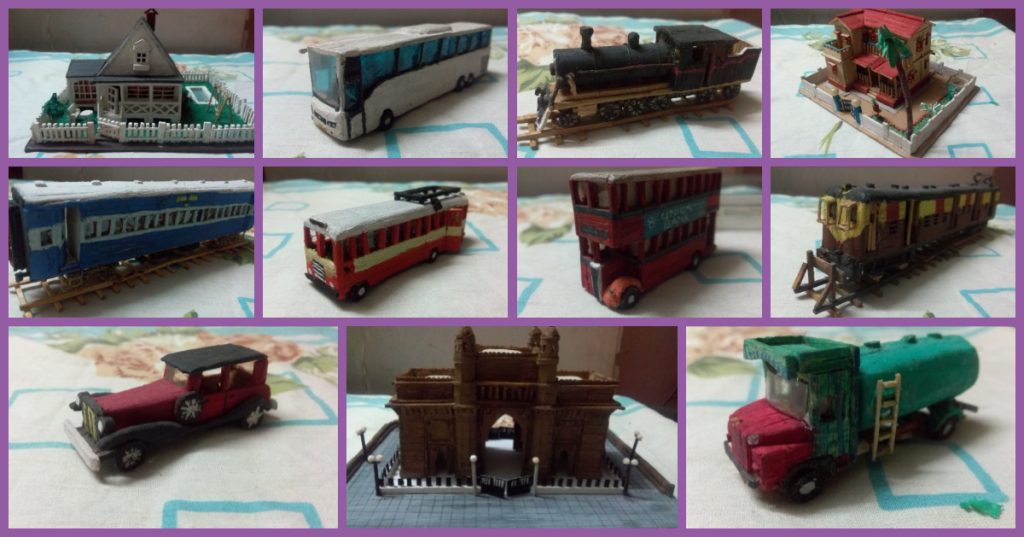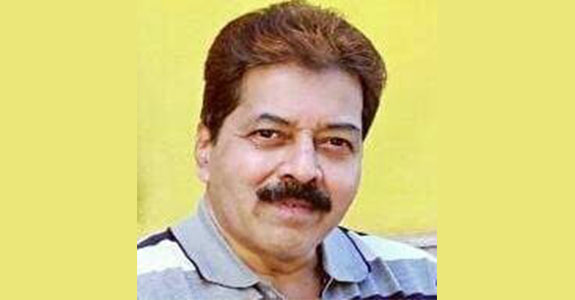
What is matchstick modelling?
Matchstick models are scale models made from matches, as a hobby. It means models made with matchbox sticks – natural or of the special modeling type. They are replicas and miniatures of the original.
What is your family background?
My father was an artist of the old era and worked as a draughtsman in the Government Ordnance depot till retirement. He was also a good charcoal sketch artist, and at home he used to make/paint saree designs and shirt designs for block printing.
His creativity perhaps has rubbed off on me too. In my childhood and school days I was good at drawing and painting ,and was also interested in crafts like making skyscrapers out of coloured cardboard paper.
Is it an ideal hobby? Do you have a special workspace for your hobby?
It is an ideal hobby if you have a flair for it. It has negligible expenses, and also needs very little space. A small table/ desk is sufficient, even a small teapoy will do.
What attracted you to this hobby?
In my teens and early twenties, I enjoyed tinkering with small blocks of wood discarded by the carpenter, and did make a few models like a lorry, locomotive, sports racing car, etc. I still retain a miniature model of a sports racing car made by me way back in 1970. It wasn’t until years later that I attempted building with matchsticks.
Landing a bank job in 1985, I was promoted and transferred to Lucknow. It gradually dawned on me that I could make models with match sticks. I thus made my first attempt at making small models of a BEST double-decker bus, and a bus stop, and gifted it to an office colleague.
However, it was intermittent. I could not devote enough time to my hobby due to job constraints. Retiring after more than three and half decades from the bank, I now devote a fair amount of my free time making matchsticks models. I don’t make complex and detailed models, but specialise and love making miniature models which can be kept on the palm of your hand. I paint them with poster colours to give them a more natural look. From models of vehicles, gradually I went on to other slightly more tiny and complex models.
How many hours do you dedicate to it daily/monthly?
Making match sticks model is a very time consuming hobby. You have to have patience and spend a lot of time on it. Once I start making a particular model, I devote a minimum of six hours daily, and sometimes even more than 10 hours.
Where do you derive your ideas from? Do you incorporate some of your own ideas and eventually your own designs?
I get ideas from magazines, newspapers, watching TV and watching life. In making match sticks models, sometimes you come across a situation where you cannot make it exactly like the original. You have to incorporate certain changes in the design and the way it should look.
How are the models constructed? What are the tools you need to get working?
First of all, you need to have some photos /pictures of the item of which you are going to make a model, and you have to conceptalise the same in your mind.
You need a few things like a glue bottle (fevicol), a few packets of shaving blades, a pincer to catch hold of small pieces, and a few shades of poster/water colours for painting the finished product, and, of course, packs of match sticks boxes.
I sort out the match sticks and use the good ones after breaking off the phosphorous ends. The models are then constructed step by step by glueing the match sticks one by one together with Fevicol.
How do you decide the thickness, terms of scale, etc.?
The terms of scale, thickness and size of the models come naturally to me, and as far as possible I try to keep the size of all the models of the same length and thickness.
Have you read about some famous practitioners of this art?
I have watched some videos on You Tube and browsed the net. They are mostly huge models which occupy lots of space. There are some famous practitioners of this art, but to be frank, I have not done serious research.
I was amazed to find that a matchstick artist Patrick Acton, 59, has painstakingly recreated a stunning replica of the Notre Dame Cathedral. He has used 298,000 matchsticks, 2000 toothpicks, and a whopping 55 litres of wood glue to assemble the 7.5ft long by 5ft high 2.3m x structure. He spent 2,000 hours on the piece, but he can take solace in the fact it took over 180 years to build the stone cathedral in Paris!
He has devoted 35 years to making matchstick models and his latest creation features a staggering array of spires, arches and towers that capture the iconic building in minute detail. He spent eight years collecting research material on the building before he began to assemble the model in 2010.
Another example is that of a retired British oil rig worker, David Reynolds, 51, from Southampton, who has completed an epic 10-year project to create a ‘matchstick armada’. He spent more than 10,000 hours gluing 250,000 matches to make a fleet of 20 legendary vessels.
Which was the first model you made and the last one? How many matchsticks did it take?
My first model was a miniature sports car made out of a single small piece of wood and my first model with match sticks was a BEST double-decker bus. It consumed about 4-5 matchboxes of sticks. My last one, a model of the famous Gateway of India, took about 20 boxes. I had to change certain things, but it still retained the overall charm.
Can you list the other of models you have created?
They include the BEST single decker bus (old), BEST double-decker bus (old and new), locomotive engine, vintage car, lorry (water tanker), Volvo bus, red air-conditioned bus, state transport bus, mono-rail with track, the Kolkata tram, village side Bungalow, English country side Cottage House, Gateway of India, Local Train, One Bogie of an Express Train, etc.
Do you use normal match sticks or special ones without combustible heads?
I use normal matchbox sticks and scrape off the combustible heads. I have not made any attempt at getting match sticks withoutcombustibles as also matchstick kits, which are available in the market. In fact, sometimes I collect and use used match sticks also. Sometimes I use toothpicks and other materials wherever it is needed, so that the final model has a more appealing effect.
How much of patience do you need in this hobby? Isn’t it a delicate art?
You need lots and lots of patience, endurance, and passion for this hobby, and at no point of time should you lose it. It is indeed very much a delicate art as sometimes you have to use very tiny pieces of match sticks for glueing and that requires immense patience. I try my best and pay particular attention to details so as to bring out the effects. The final model must look like the real ones.
Have you considered making the hobby a commercial one?
No, it is tempting but this is purely a hobby where I derive great satisfaction. I haven’t thought about it commercially. I don’t think anybody would like to pay much for such miniatures, at least in India. But I am open to the idea.
Do you think this hobby has to be more popularised?
Yes, I do as I don’t see many people taking it up. I guess with the fast pace of daily life, nobody likes to devote and spend their valuable time in such a time consuming hobby.
Would you like to teach others this hobby?
Personally I am not averse to teaching this art to anybody who is interested and who wants to learn it. One drawback of this hobby is that once you are engrossed in it, you don’t feel like doing anything else, and only strive to complete it at the earliest.
However, I’m not sure if I’ll be able to pass on my legacy to an apprentice, as it’s hard to find kids with such attention span.
Are you working on any models at present?
Yes, many. A typical Mumbai chawl, a formula 1 sports car, a one-storied ferry boat, my society building, small showcase / cabinet, an urban/city bungalow, local train(new), metro train, etc.

